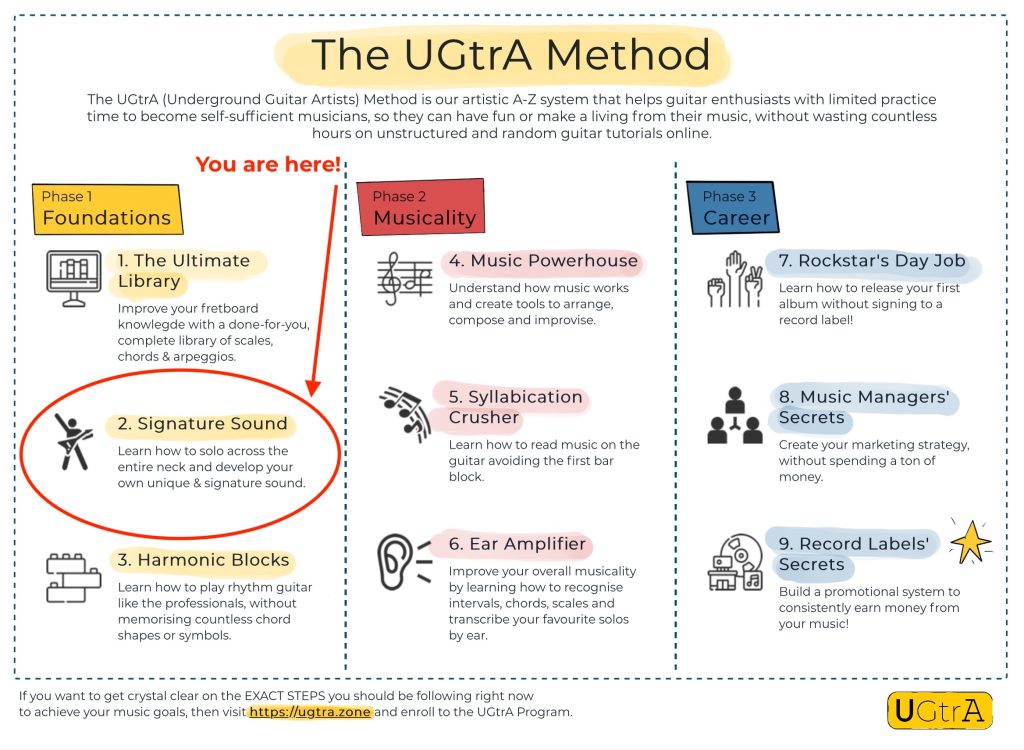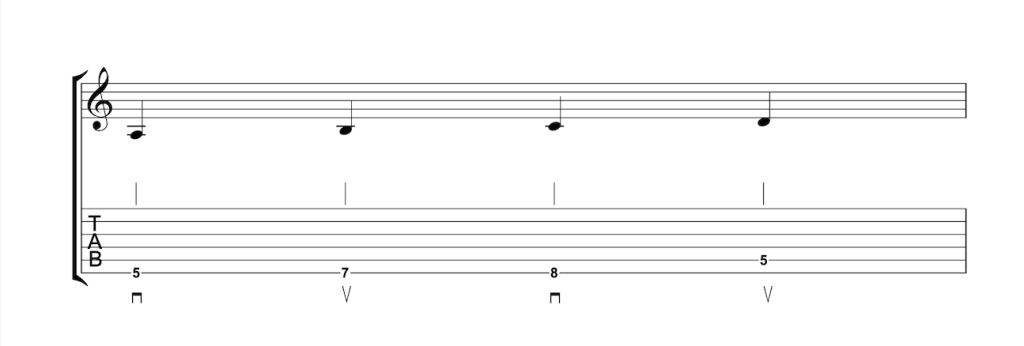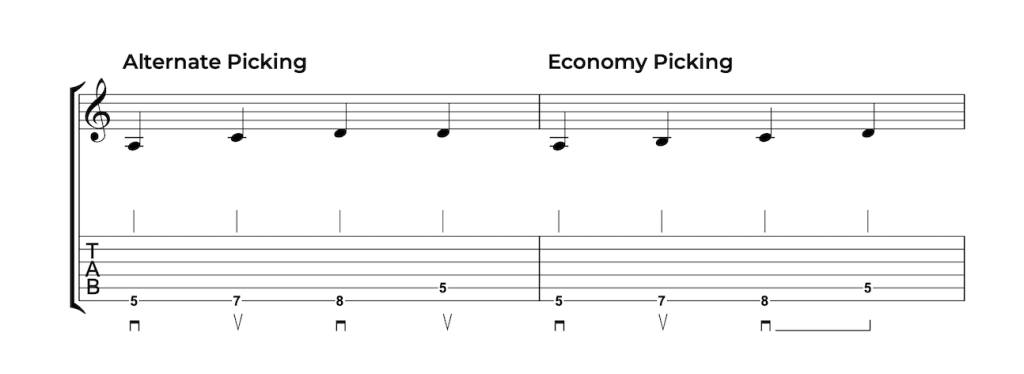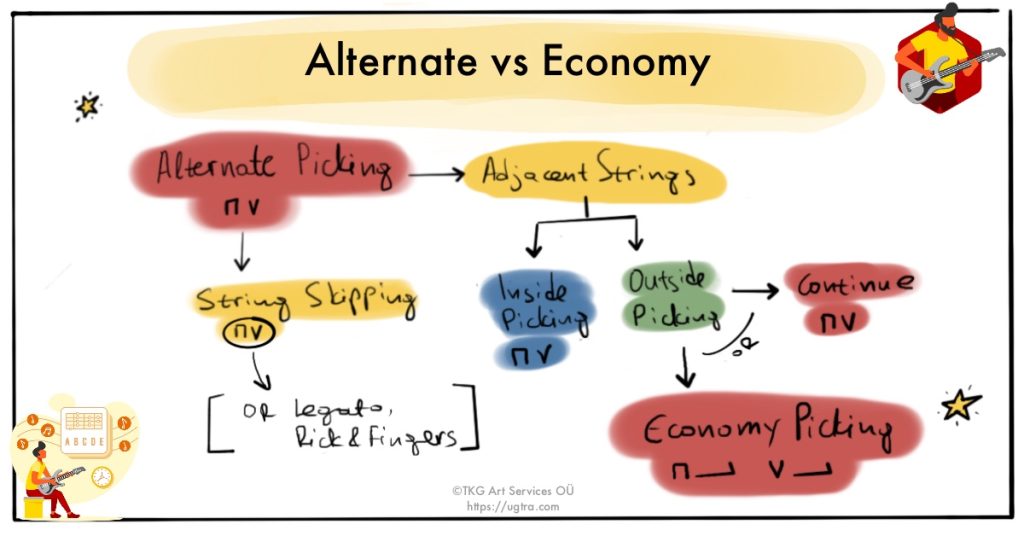Before we’ll delve into the alternate picking vs economy picking battle, let me ask you a question:
Do painters use the same direction of brush strokes when painting, or do they alternate between up and downstrokes?
The correct answer is…
It depends.
On what?
On the texture, they want to achieve.
This is the same for us, the guitarists.
I’m telling this upfront.
There’s no alternate versus economy or whatever rivalry.
The question is simple:
As a guitar artist, what timbre would you like to achieve?
More on that in a minute.
For now, let’s see where this article fits in our UGtrA Method.


Alternate and economy picking are electric guitar techniques.
We practice them using a metronome to build speed, accuracy, muscle memory, quality of notes, etc.
So, we are at step 2 of our method – The Signature Sound.
Now, let’s take it from the top.
What is the Alternate Picking Technique?
Alternate picking is the most common electric guitar technique.
In simple terms, alternate picking is the continuous alternation between downstrokes (downward picking) and upstrokes(upward picking).
No matter if a line consists of notes on a single or multiple strings, the alternate motion of the picking direction should be maintained.
Let’s take a simple example that we’ll use later on, as well.
Example 1:


As you can see, we start with a downstroke and then alternate the picking motion between up and down, regardless of the string change.
Now, let’s look at another example.
Here’s the A Natural Minor scale using a 3-notes-per-string shape (read more on How to Design Scales for Fast Playing).
Example 2:


Notice again how the picking motion alternates consistently between up and down.
How Can Alternate Picking Benefit Your Playing?
Alternate picking can produce the most articulated sound of all the guitar techniques.
This is because all the notes are played using a single picking stroke.
Additionally, alternate picking can be employed to execute fast runs, as it takes advantage of both picking directions.
Think about it.
Let’s say you have 2 notes in a row on a single string (like in the popular pentatonic scale shapes that consist of two notes per string).
If you were to play them using only downstrokes, you’d have to play the first note and then raise your pick to bring it above the string to execute the second downstroke.
[The same applies if you’d like to play them using only upstrokes.]
That means you waste a motion – raising the pick without producing a note.
Alternate picking eliminates this wasted motion by producing a note with the upstroke.
That way, we can achieve high speeds with well-articulated notes.
[Recommended Read: How to Improve Your Alternate Picking: A SStrategic Approach to Master the Most Common Guitar Technique]
What is the Economy Picking Technique?
Unlike alternate picking, where the player consistently alternates between downstrokes and upstrokes, economy picking breaks that rule when transitioning between adjacent strings from the outside.
Many guitar heroes, such as Eric Johnson and Yngwie Malmsteen, make extended use of eco picking, characteristic of their fluid sound.
Let’s revisit Example 1 and see the difference.


Notice that with alternate picking, we end on the 6th string with a downstroke (hitting the upper side of the string) and then move to the 5th string with an upstroke (hitting the lower side of the string), executing what we call outside picking – picking from the outside of adjacent strings.
On the other hand, with economy picking, we continue to the 5th string, maintaining the same downward motion of the pick.
This sweeping motion of the pick reduces the physical effort required to pick the string from the outside and allows for smoother, and sometimes faster, playing, making it a favored technique among many guitarists.
Let’s now see how Example 2 is transformed using economy picking:
Example 2 using economy picking:


You can see a repetitive pattern of Down-Up-Down picking directions throughout the passage.
There are times though, when we move between adjacent strings using inside picking.
In those cases, economy picking is not possible.
For example, let’s see the following example.


Here, we have two notes on the second string and two on the first one.
Notice that we end the line on the second string with an upstroke and then change strings from the inside to a downstroke.
This is clearly an alternate picking passage.
If we reverse the picking directions (yes, we can start with an upstroke in some cases), we have this:


Now, the line becomes an economy picking passage.
So the question is:
Should I preplan my playing to incorporate economy picking?
I would say that, at first, start with what feels more convenient to you.
As you progress and build your technique and muscle memory on both picking methods, you can be more selective according to the timbre you want to achieve [more on that later].
How Can Economy Picking Benefit Your Playing?
By removing the outside picking out of the equation, economy picking can significantly enhance your guitar playing by improving your speed, efficiency, and overall fluidity.
Outside picking is considered by many to be the most difficult part of alternate picking.
Keeping the same picking direction when crossing strings minimizes hand movements and allows for smoother transitions, improving your ability to play fast and complex passages with precision.
Alternate Piking vs Economy Picking. Which is the Best Guitar Picking Technique?
Well, there is no such thing as the best guitar picking technique.
As I mentioned in our Underground Guitar Artist (UGtrA) Manifesto, our point of view is always an artistic one.
I started this article by talking about timbres, and this is the magic word.
Each guitar technique has its own unique timbre.
[recommended reading:
👉The 6 Essential and Advanced Electric Guitar Techniques You Must Know, and
👉The 8 (Easy) Electric Guitar Techniques that Will Give Emotions and Colors to Your Lines.]
So, the right question here would be, Which TIMBRE would I like to achieve at that particular moment of my playing?andthere you have the answer to Which is the Best Guitar Picking Technique for THAT OCCASION.
Some guitar players prefer strict alternate picking, some strict economy picking, and others use both.
I belong to the third category.
I believe that as artists, we need to have a range of expressive tools and guitar techniques that create various timbres so we can choose the “appropriate” one, according to our personal artistic choice, at any given time.
